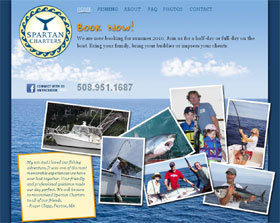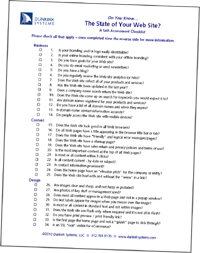New Web Site Launched For Spartan Charters
 At Dunkirk Systems, LLC we are proud to have brought many clients to the Web for the first time. With the launch of the Web site for charter fishing service Spartan Charters we continue along this great tradition.
At Dunkirk Systems, LLC we are proud to have brought many clients to the Web for the first time. With the launch of the Web site for charter fishing service Spartan Charters we continue along this great tradition.
Spartan Charters is a full service charter company servicing Cape Cod, the Islands, and Southeastern Massachusetts and is a complete fishing guide and charter service. With their fleet of great fishing vessels and 2 experienced captains, Spartan ensures you have a quality and great fishing experience. As they say, they target big fish.
For this project Dunkirk partnered once again with Visible Logic, Inc. to great a highly functional Web site with a great design. The home page design is compelling to draw users to the various sections within the Web site, plus all navigational links are stylized text links, rather than images. A custom-developed content management system (CMS) powers the Web site allowing the Spartan Charters team to modify all Web site content. They are also embracing social media with their Facebook page and Flickr account with a wide variety of photos from past trips and catches.
Whether you’re a seasoned fisherman or looking to entertain clients or guests with a fishing experience, Spartan Charters is the one to call… or contact through their new Web site.
Did you enjoy reading this? You are welcome to subscribe to The Hot Iron by RSS feed or by email.
Linking To Content You Cannot Link To
 Believe it or not, there are times you want to directly link to something from your Web site but you cannot. Despite this, there are ways you can still promote what it is you want to link to.
Believe it or not, there are times you want to directly link to something from your Web site but you cannot. Despite this, there are ways you can still promote what it is you want to link to.
What Possibly Are You Talking About?
The following are a few scenarios where you cannot directly link to something on the Web.
- The publication’s Web site does not post its articles online
- The publication’s Web site requires registration or payment to view the article
- The article is no longer on the publication’s Web site
There are all real-life scenarios and have happened to clients as well as myself.
Credit Where Credit Is Due
Whenever you are referencing content belonging to someone else on the Web, it is always a good idea to get their permission. In some cases you may not be able to mention specifics, such as a company or publication name or even the title of the work or article, but you’ll want to find out as much as you can about what you can mention.
Here’s a real example, and names have been changed to protect the innocent. A client of mine wants to link to articles she writes for a cooking magazine on her Web site, and in some cases she even wants to republish full or partial copy from the article. The published does not post articles online, and does not want her to post any of the articles on her own site. However, she can mention the name of the magazine, issue date and number, article title and page number. She can even show a thumbnail of the magazine cover. In this case, we posted all of this information, plus the photo, with a link to the magazine’s Web site.
If, for example, the article is available online but only to online subscribers, we can still link to it, and below the link we can mention this is behind a login which requires signup and payment. This brief disclaimer will show goodwill to the magazine, all the while promoting the fact the client wrote in it.
Striving for the Win-Win
In-bound links to a Web site are always desired and welcomed by a site owner. Depending on your business relationship with a Web site may dictate how you can present a link to promote yourself with their name. If the situation arises, seek out the method where you can present the most you can, and as a result creating a win-win situation.
Did you enjoy reading this? You are welcome to subscribe to The Hot Iron by RSS feed or by email.
Dunkirk Systems, LLC Releases The State Of Your Web Site – A Self-Assessment Checklist
 Do you know The State of Your Web Site?
Do you know The State of Your Web Site?
From a client or prospect meeting to a summer picnic, I am involved in many conversations about Web sites. Some people brag about how much they love their Web sites. On the obvious flip-side, many say they hate their Web site. As the conversation flows to some depth, I often find in most cases people cannot quantify what it is they like or dislike about the Web site. By quantifying. I am referring to elements of a Web site which may be working or not working for the site owner, but no specific knowledge of which ones and their status.
In short, they do not know The State of Their Web Site.
To help add clarity and guide change to a Web site, my Web consulting firm Dunkirk Systems, LLC has developed The State of Your Web Site. It is a free, no obligation self-assessment checklist where a non-technical owner of a Web site can review the 34 questions on the checklist and move toward an objective answer to this question. You can download a PDF copy for free at TheStateOfYourWebSite.com.
Emphasis On The Non-Technical Owner
One goal of The State of Your Web Site is to help the non-technical owner of a Web site. Why? From our experience at Dunkirk, which includes my own personal experience with developing software for over 20 years, most “owners” of a Web site or any business application is they are not technical. They may understand technology, but they are most likely not programmers or technicians. Despite this, it doesn’t mean you cannot recognize issues or opportunities for improvements with your Web site. These questions are at a level where if the answer is not known or found to be at issue, a more thorough check by a technician can be made to gain its scope and make a recommendation.
Focus On Business, Content and Design
The checklist is broken into 3 categories – business, content and design – and each has specific questions related to these areas, and of course all can be answered from a non-technical aspect. The idea was where you could place this checklist in front of you, go through each question and navigate through your Web site to see whether you can check it off or not. These are not trick questions – they are presented in a straightforward, objective manner. That being said, someone may not know what a question is asking, which is another opportunity to learn.
Get Your Copy and Learn The State of Your Web Site
There is no obligation or any requirement of your name and personal information to get a free copy of The State of Your Web Site checklist. Feel free to pass along the link to your friends or colleagues, or simply send them a copy of the checklist! But once you use it, you may have questions on some or all questions presented, not to mention you may be ready to take the checklist to the next level and want an detailed Web site assessment. We do have a contact form on the checklist landing page where you can contact Dunkirk, or you can use the contact form on our Web site at DunkirkSystems.com.
In-Depth Converation On Each Question to Follow
Going forward, I will feature in-depth conversation on each question on the checklist here on The Hot Iron. I welcome your questions and comments on each. Together, we can all have a firm grasp on The State of Your Web Site.
Did you enjoy reading this? You are welcome to subscribe to The Hot Iron by RSS feed or by email.
What Is A Favicon And Why Does Your Web Site Need One
As a Web site owner, today you must do everything you can to draw traffic to your Web site. There are the obvious methods of doing so – links to your Web site, search engine optimization (SEO) and search marketing. All of these are an ongoing process which of course will take time and money.
Many people forget something obvious – visually drawing traffic to your site. The most common way this plays out is when you are navigating bookmarks or manually typing a URL in your browser address bar and a list of previously-visited Web sites appears. Along with those addresses and Web site titles, there may also be an icon appearing. This is called a favicon, and your Web site should not be without one.
Favicon is a contraction of “favorites icon” and is yet another way for your Web site to stand out. It is technically an icon file on your Web server that is referenced in your Web pages and is displayed in the browser. Below is an example of favicons which appear both on the address bar and tabs of my Firefox browser.
![]()
![]() If you bookmark a Web page that has a favicon, it will also appear in your list of bookmarks, as shown in the accompanying screenshot. Favicons may also appear on mobile browsers as well. Note however favicons may not appear on older browser versions, as I have written before are still out there and in use. Most all current browsers will display them. As you can see, a favicon will help your Web page stand out among the others. It can also reinforce your branding beyond the Web page itself, helping lead people back to your Web site if they liked what they saw the first time.
If you bookmark a Web page that has a favicon, it will also appear in your list of bookmarks, as shown in the accompanying screenshot. Favicons may also appear on mobile browsers as well. Note however favicons may not appear on older browser versions, as I have written before are still out there and in use. Most all current browsers will display them. As you can see, a favicon will help your Web page stand out among the others. It can also reinforce your branding beyond the Web page itself, helping lead people back to your Web site if they liked what they saw the first time.
![]() So what happens if your Web site does not have a favicon? You will see a blank rectangle resembling a piece of paper or simply nothing where the favicon would be, as shown in the accompanying screenshot. As a result, the title of the particular Web page which was bookmarked will have to do all of the work to visually draw people. Again, how does the saying go, a picture is worth 1,000 words?
So what happens if your Web site does not have a favicon? You will see a blank rectangle resembling a piece of paper or simply nothing where the favicon would be, as shown in the accompanying screenshot. As a result, the title of the particular Web page which was bookmarked will have to do all of the work to visually draw people. Again, how does the saying go, a picture is worth 1,000 words?
If your Web site does not have a favicon, contact your Web site designer or developer and ask for one. Of course if you are unsuccessful, you can always contact us at Dunkirk Systems, LLC and we would be more than glad to work with you to make it happen. A favicon is a literally small file that can have a large impact on your Web site.
Did you enjoy reading this? You are welcome to subscribe to The Hot Iron by RSS feed or by email.
Plan And Budget For Web Site Repairs
Every time I walk by this it cracks me up, so much that I had to take a picture of it and talk about it here, and how it related to the Web. Below is a photo of part of a sidewalk in Chicago near the northeast corner of Madison and Canal Streets. And what you think you may see is correct, a piece of metal bolted over a hole in the sidewalk.

As peculiar as it appears, unfortunately it is not an anomaly. There are many sidewalks in the Windy City which are patched with metal or plywood. This is most likely the result of the fact that many sidewalks are vaulted (or hollow underneath) which is a throwback to the days when the only way you could get goods into a building were through a lift in the sidewalk to the basement. As the logistics – and cost – to repair a vaulted sidewalk are high, many times something is just bolted over the hole to cover it.
Ideally, the owner of a building with a vaulted sidewalk should be aware of their condition and appropriately budget for its repair or replacement, just as they should be anticipating other repairs in the building. The same holds true for the owners of Web sites.
Web Sites Need Repairs Too
There are 2 cases when a Web site needs to be repaired, with one being driven by the business and the other by technology.
From a business standpoint, a Web site should be closely synchronized with the entity it represents. This includes everything from an accurate phone number to an extension of services offered by the entity to the Web site. If the content of your Web site frequently changes and the site doesn’t have a content management system (CMS) then you should consider adding one, thereby reducing the cost of manually maintaining content. If you send statements or other documents to your customers, making these available on your Web site could reduce labor and mailing costs to get these out. As social media tools become more robust, integrating them into your Web site will give you an advantage to reach out to your fans and followers, who hopefully will become customers.
Technical repairs to a Web site can greatly vary. Whenever a new version of a Web browser is released, your Web site should be tested against it. In some cases, some code on your Web site, such as JavaScript, may not work in a new version. The Web site itself didn’t change, the browser did. As Apple is not allowing Flash to be displayed on the iPhone and iPad, if you have it on your Web site, it will not display on these 2 devices. As smartphones become more and more common, your Web site may require a mobile version to best display on these smaller-screened devices.
Be Prepared
Just as with a home or car repair, Web site repairs will need your time to be addressed, will need to be scheduled and will cost money. Where you cannot always anticipate when repairs will be needed (just as you can’t predict when your refrigerator will stop working) it is best to set aside some funds for your Web site’s eventual repair. How much you will need to save will depend on the size and complexity of your Web site, and your Web consultant can help you with this decision-making. As well, they can help you with identifying potential problem areas and recommend a schedule for you as well. If they cannot, feel free to contact Dunkirk Systems, LLC, as we are more than glad to talk to you about how to best manage your Web site.
Did you enjoy reading this? You are welcome to subscribe to The Hot Iron by RSS feed or by email.

